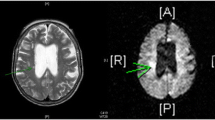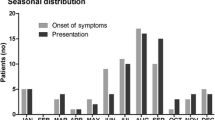Summary
Meningococci and Haemophilus influenzae may invade the subarachnoid space during the bacteriaemic phase without impairment of the blood-CSF barrier and in the absence of any leucocyte reaction. In pneumococcal meningitis the CSF may also contain less than 100 cells/μl despite the presence of “pure bacterial cultures”, but the barrier is completely broken when the serum/CSF concentration ratio is below 10. A clinical analysis of eight patients with fewer than 100 cells/μl revealed that the first symptoms of meningitis appeared at least 3 days prior to the diagnostic lumbar puncture. There was a strong neutrophilic reaction in the blood with a prevalence of juvenile forms in most cases, indicating intact antibacterial defence mechanisms. Within 24 h after the start of antibiotic therapy the cell number rose above 2000/μl accompanied by disappearance of pneumococci. Six of the eight patients died. In three cases autopsy revealed thick layers of pus over the convexities, indicating a compartmental separation of the ventricles and the spinal subarachnoid space. In one case of late diagnosed bacterial meningitis with a pleocytosis of 430/μl the CSF lysozyme level was seven times higher than compatible with this cell number. Hyperphagocytosis and cellular disintegration is thought to cause the leucopenia within the spinal CSF compartment. “Apurulent bacterial meningitis” can be seen as a disease entity that is a diagnostic pitfall and also a prognostic sign.
Similar content being viewed by others
References
Converse GM, Gwaltney JM, Strassburg DA, Hendley JO (1973) Alteration of cerebrospinal fluid findings by partial treatment of bacterial meningitis. J Pediatr 83:220–225
Eigler JOC, Wellmann WE, Rooke ED, Keith HM, Svien HJ (1961) Bacterial meningitis. Proc Mayo Clin 36:357–365
Feldman WE (1977) Relation of concentrations of bacteria and bacterial antigen in cerebrospinal fluid to prognosis in patients with bacterial meningitis. N Engl J Med 296:433–435
Felgenhauer K (1982) Differentiation of the humoral immune response in inflammatory diseases of the central nervous system. J Neurol 228:223–237
Felgenhauer K, Ackermann R, Schliep G (1980) The process dynamics of viral and bacterial disease of the central nervous system. J Neurol Sci 47:21–34
Fishman RA (1980) Cerebrospinal fluid in diseases of the nervous system. Saunders, Philadelphia
Greenwood BM (1978) Chemotactic activity of cerebrospinal fluid in pyogenic meningitis. J Clin Pathol 31:213–216
Hansen NE, Karle H, Valerius NH (1978) Neutrophil kinetics in acute bacterial infection. Acta Med Scand 204:407–412
Heitmann R, Schuchardt V (1984) Bakterielle Meningitiden. Nervenheilkunde 3:125–131
Holubarsch Ch, Galle J, Haferkamp O (1979) Über den Mechanismus der Freisetzung lysosomaler Enzyme aus neutrophilen Granulozyten. Virchows Arch [Cell Pathol] 30:63–76
La Scolea LJ, Dryja D (1984) Quantitation of bacteria in cerebrospinal fluid and blood of children with meningitis and its diagnostic significance. J Clin Microbiol 19:187–190
Marsh JC, Boggs DR, Cartwright GE, Wintrobe MM (1967) Neutrophil kinetics in acute infection. J Clin Invest 46:1943–1953
Merrit HH, Fremont-Smith F (1983) The cerebrospinal fluid. Saunders, Philadelphia
Moore CM, Ross M (1973) Acute bacterial meningitis with absent or minimal cerebrospinal fluid abnormalities. Clin Pediatr 12:117–118
Nolan CM, Clark RA, Beaty HN (1975) Experimental pneumococcal meningitis. III. Chemotactic activity in cerebrospinal fluid. Proc Soc Exp Biol Med 150:134–136
Petersdorf RG, Swarner DR, Garcia M (1962) Studies on the pathogenesis of meningitis. II. Development of meningitis during pneumococcal bacteremia. J Clin Invest 41:320–327
Quaade F, Kristensen KP (1962) Purulent meningitis. Acta Med Scand 171:543–550
Scheid W (1983) Lehrbuch der Neurologie. Thieme, Stuttgart
Schmuziger P, Wegmann T (1965) Die eitrige Meningitis — Therapie und Prognose. Schweiz Med Wochenschr 95:149–161
Smith AL, Smith DH, Averill DR, Marino J, Moxon ER (1973) Production of haemophilus influenzae b. Meningitis in infant rats by intraperitoneal inoculation. Infect Immun 8:278–290
Smolen JE, Weissmann G (1978) The granulocyte: Metabolic properties and mechanisms of lysosomal enzyme release. In: Havemann K, Janoff A (eds) Neutral proteases of human polymorphonuclear leucocytes. Urban & Schwarzenberg, Baltimore Munich, pp 56–75
Spilkin ES, Rachmaninoff N, Climie ARW (1968) Listeria monocytogenes meningitis. Am J Clin Pathol 49:671–676
Spitznagel JK (1978) Intracellular and extracellular degranulation of human polymorphonuclear azurophil and specific granules induced by immune complexes. In: Havemann K, Janoff A (eds) Neutral proteases of human polymorphonuclear leucocytes. Urban & Schwarzenberg, Baltimore Munich, pp 82–85
Statz A, Wenzel D, Felgenhauer K (1979) Blut-Liquor-Schranke und lokale Immunantwort im Verlauf von Meningitiden im Kindesalter. Neuropädiatrie 10:281–289
Swartz MN, Dodge PR (1963) Bacterial meningitis — a review of selected aspects. N Engl J Med 272:779–787
Tugwell P, Greenwood BM, Warrell DA (1976) Pneumococal meningitis: a clinical and laboratory study. Q J Med 180:583–601
Zeya HI, Spitznagel JK (1969) Cationic proteins of polymorphonuclear leucocyte lysosomes. J Bacteriol 91:750–754
Author information
Authors and Affiliations
Rights and permissions
About this article
Cite this article
Felgenhauer, K., Kober, D. Apurulent bacterial meningitis (compartmental leucopenia in purulent meningitis). J Neurol 232, 157–161 (1985). https://doi.org/10.1007/BF00313892
Received:
Revised:
Accepted:
Issue Date:
DOI: https://doi.org/10.1007/BF00313892




